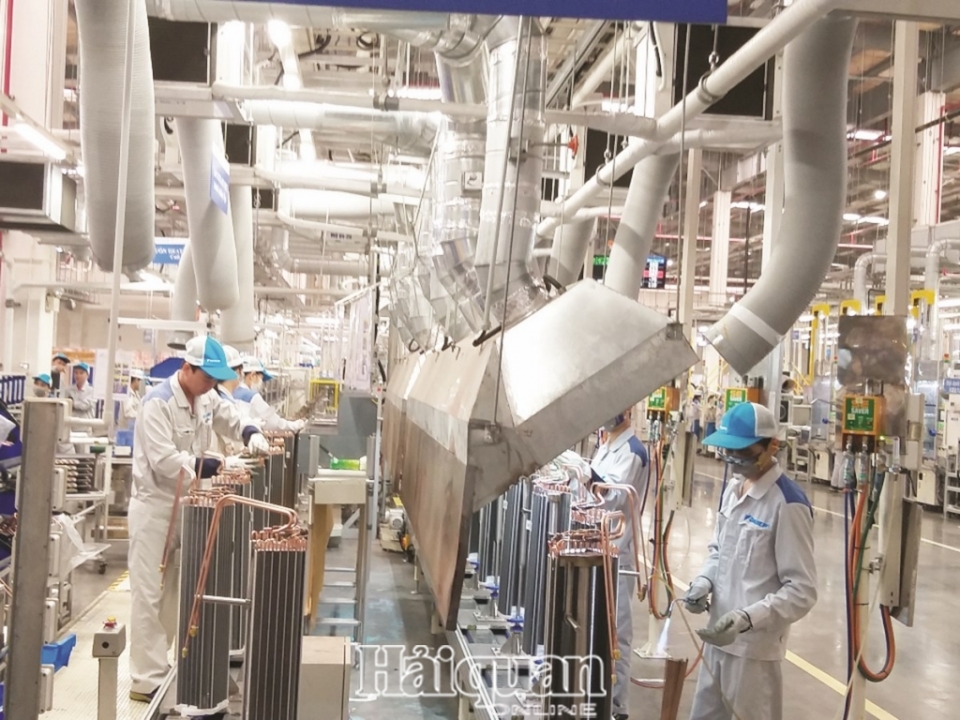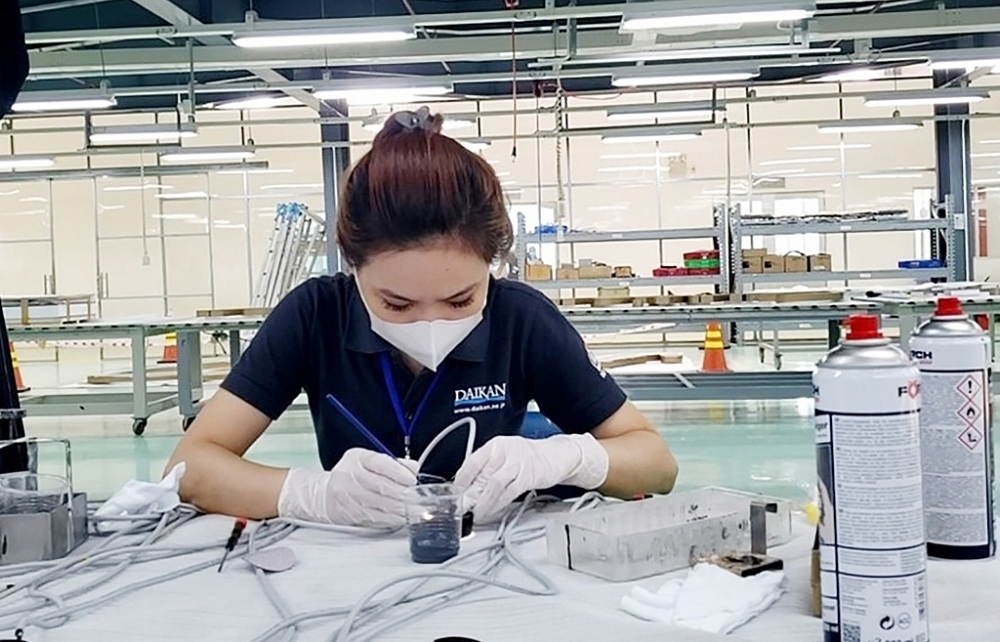Chinese investors flock into Vietnam
 |
| In seven months, China was the largest investor with $1,785.6 million, accounting for 21.6 percent of the total newly registered capital. Photo: Nguyễn Thanh |
Welcome five to eight investors each week
According to the Ministry of Planning and Investment, the total amount of foreign direct investment (FDI) capital in Vietnam in the first seven months of this year reached $11,698 million, down by 35.6 percent compared to the same period in 2018. FDI in seven months was estimated at $10.6 billion, increasing by 7.1 percent over the same period in 2018. Notably, among 65 countries and territories that weregranted license for newly investment in Vietnam in seven months, China was the largest investor with $1,785.6 million, accounting for 21.6 percent of the total newly registered capital.
Talking to reporters of Customs News, Phuong said that in general, the current wave of FDI investors studying investment in Nam Dinh Vu Industrial Zone (Sao Do Group-owned) as well as in Hai Phong city in general, has increased quite a lot. The number of investors currently seeking investment has increased three times compared to the same period last year. Most of them were investors from China. Specifically, the rate of Chinese investors previously only accounted for 40 percent, it has increased to 70-80 percent. It’s mean that, in the past, among 10 customers of Sao Do Group there were 4 Chinese customers, there are 7-8 Chinese customers nowadays.
“Up to now, Sao Do Group has worked with hundreds of Chinese investors. “On average, I have met 5-8 Chinese investors per week. Almost investors comeevery day. Even, there is a group of investor of 15-20 enterprises”, Phuongsaid.
With foreign investors that used to invest in China considering the Vietnamese market, Phuong said those investors mainly come from South Korea and Japan. They did not say it was the investment shift, it was just only an expansion of production investment while maintaining a factory in China and expanding investment to Vietnam. “However, I thought it was a shift. In the short term, maybe,the investors maintained factories in China, expanding more investments in Vietnam, but in the long term, they would probably close factories in China,” Phuong indicated.
Trade war leads to investment for tax avoidance?
Currently, Chinese investors come to learn about Nam Dinh Vu industrial park which operates in diverse fields such as furniture, household appliances, toys and accessories for the electronics automotive industry.
According to Phuong, there were enterprises that sent experts to work four to five times with Sao Do Group, conduct surveys, compare geology, conditions, sources of input materials, conditions of license and legal issues but they have not yet decided to invest. On average, Chinese investors have taken at least four to six months to make a decision. However, there was also case of Japanese investors, although they have come to find out for nearly two years, they have not made a decision yet.
In the future, Phuong assessed the potential of investment shift from China to Vietnam. In terms of land fund, Sao Do Group has ready to meet the demand of about 150ha for investors. Besides that, the Group has also ready to meet the demand for electricity, water and energy with a capacity of about 60MW.
Regarding the impact of the US-China trade war on the shift of investment from China to Vietnam, economic expert Tran Toan Thang shared with Customs News that the risks from Chinese economy, especially trade war could lead to a rapid increase in investment flows from China into Vietnam because investors want to avoid additional taxes when exporting to the US. The data for the first months of 2019 also illustrated this fast rising trend. However, it should be noted that in 2019, Vietnam also has two FTAs, creating more opportunities for investors that were the Comprehensive Partnership and Trans-Pacific Partnership Agreement (CPTPP) and Vietnam-EU FTA. (EVFTA). Therefore, it was difficult to separate the real impact of trade war on investment from China into Vietnam.
“In terms of principle, it could be seen more about the type of production. If it was an investment of assembly based on the input components imported from China, it could be considered asinvestmentfor tax avoidance. However, if enterprises invest in inputs producion for other enterprises, it could be considered as a result of more FTA impacts. However, at present, we did not have enough information to separate so it was difficult to make a conclusion. Of course, logically, trade war could lead to such a tax avoidance,”Thang said.
However, local authorities have still expressed caution and fearinvestors may bring in old and lost technologies to Vietnam.
Thang also assessed that this was a major concern today. Investment shift from China (including both Chinese enterprises and FDI enterprises in China), especially upstream industries could lead to the consequences for the environment. Regarding investment registration, Vietnam has taken steps to control this (for example: technology appraisal committee, or appraise and approve environmental impact assessment reports). The question was that how to implement those steps in practice?
“Actually, in terms of regulation, it was difficult to have a separate screening mechanism for investors from China because Vietnam has integrated and applied fair treatment to investors. The problem lies in the implementation and supervision of the implementation of regulations and the awareness of local authorities related to attracting FDI,”. Thang said.
Related News

Amendment of Special Preferential Import and Export Tariff Schedule to Implement CPTPP Agreement for the 2022-2027 Period
14:20 | 09/10/2024 Regulations

Binh Duong hopes to attract FDI investment in the high-tech field
16:51 | 27/07/2024 Import-Export

Enterprises in Dong Nai industrial zones quickly recover production
09:43 | 25/10/2021 Import-Export

Hanoi attracts over 840 million USD in FDI in eight months
19:53 | 31/08/2021 Import-Export
Latest News

Sustainable opportunities for Vietnamese goods to penetrate the global market
13:54 | 30/12/2024 Import-Export

Top brands in Việt Nam in 2024 revealled
13:54 | 30/12/2024 Import-Export

Vietnamese catfish exports to hit $2 billion mark this year
13:52 | 30/12/2024 Import-Export

Is the 12% export growth target for 2025 achievable?
13:50 | 30/12/2024 Import-Export
More News

Increase revenue from building a sustainable supply chain
11:04 | 30/12/2024 Import-Export

Coconut export enter acceleration cycle
11:02 | 30/12/2024 Import-Export

Pepper export value reaches highest level since 2017
17:58 | 29/12/2024 Import-Export

Fraudulent planting area codes threaten Việt Nam’s durian exports
17:52 | 29/12/2024 Import-Export

Industrial production maintains rapid and throughout bounce back
14:26 | 29/12/2024 Import-Export

Halal Market: The Door is Wide Open, How to Exploit It
14:23 | 29/12/2024 Import-Export

Việt Nam becomes second biggest garment exporter globally
18:06 | 28/12/2024 Import-Export

Fraudulent planting area codes threaten Việt Nam’s durian exports
18:03 | 28/12/2024 Import-Export

Trade remedies protect domestic industries
13:49 | 28/12/2024 Import-Export
Your care

Sustainable opportunities for Vietnamese goods to penetrate the global market
13:54 | 30/12/2024 Import-Export

Top brands in Việt Nam in 2024 revealled
13:54 | 30/12/2024 Import-Export

Vietnamese catfish exports to hit $2 billion mark this year
13:52 | 30/12/2024 Import-Export

Is the 12% export growth target for 2025 achievable?
13:50 | 30/12/2024 Import-Export

Increase revenue from building a sustainable supply chain
11:04 | 30/12/2024 Import-Export





